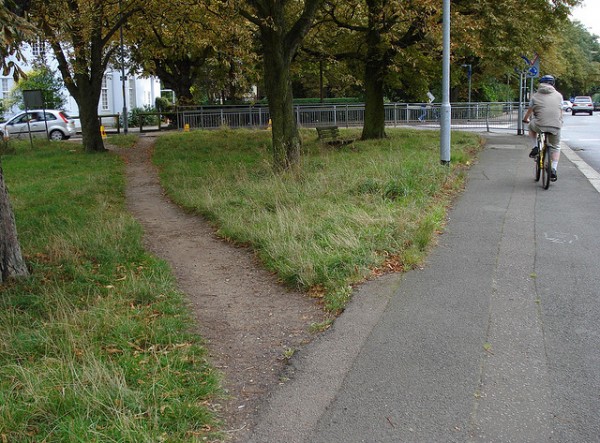Thinking in Desire Paths
A failing in all design thinking is faith you can perfectly predict human behavior. Often a wiser strategy is to observe first, try to understand, and only then predict.
There’s an old concept among architects and urban planners called desire paths. If you walk around a college campus, or urban park, it’s easy to spot the well tread paths between buildings people have made for themselves. These are desire paths, or desire lines. The natural behavior among people shows you where the optimal path should be.
(Photo by Kate Pugh)
There’s a likely apocryphal story about a college campus that didn’t put any paved paths in until the second year. For the first year they waited to see the paths the students and staff had made, and put the paved paths over them in the second year.
This idea extends beyond courtyards and urban planning. You can think in desire paths for nearly any kind of design problem. Take for example, dialog in film-making. Here’s a story from the making of Scorsese’s GoodFella’s:
According to Pesci, improvisation and ad-libbing came out of rehearsals where Scorsese let the actors do whatever they wanted. He made transcripts of these sessions, took the lines that the actors came up with that he liked best, and put them into a revised script that the cast worked from during principal photography. For example, the scene where Tommy tells a story and Henry is responding to him — the “what’s so funny about me” scene — is based on actual event that happened to Pesci. It was worked on in rehearsals where he and Liotta improvised and Scorsese recorded 4-5 takes, rewrote their dialogue and inserted it into the script.
The idea of prototyping, if done right, allows for many paths to be explored, either by actual users, or even through your own imagination. In the case of Goodfellas, the different possible paths were explored by the actors, and they gravitated towards one that worked well. Scorsese was simply openminded enough to let them explore and again in choosing to use the results. Rather than invent everything out of their own mind, wise creators know a little observation can be an easier way to find the right ideas.
Also see: Flickr photo pool of desire paths


“Rather than invent everything out of their own mind, wise creators know a little observation can be an easier way to find the right ideas.”
This is applicable to so many things. The world would be a better place if we all listened to each other and were open to experimentation.
So true!! Just thinking why very less things are built that way?
* People just want to finish one task faster to move to the next one.
* Fear of competition.
* No love for the task. Doing it for the sake of it or no ownership!
Spot on!
I’ve been chewing on one nut for over 35 years … it’s all about how folk form opinions … and I spent 30 of those years drilling down through what “meaning” means. The sort of thing that no IBM Watson will ever be capable of: why things are significant to human individuals.
When my design came clear? It truly was a eureka moment: things fell into place because I’d drilled down to something foundational. (And yes, I remember the moment very clearly. I can even describe what jogged my brain! I describe it as finding a “quantum valley” … 108,000 sites out there /almost/ get it, but not quite.)
@bentrem
p.s. I think what we’re seeing is an 80 / 20 economy: 80% of users use 20% of the software or system, so nothing ever gets stressed. And precious little is achieved.
Very interesting post! Two thoughts:
(1) In relation to highway speed limits, there is a concept called the 85%ile speed, which posits that the safest speed limit–because it reduces speed disparities between vehicles and reckless driving–is the 85%ile speed on a given stretch of road if there were no posted speed limit.
(2) In relation to letting the script of a movie emerge organically from the interactions of the actors, this is supposedly in large part how Christopher Guest created such amazing hilarious movies, such as This Is Spinal Tap and Best In Show. A great example–if it really is true–in my opinion would be Fred Willard as Buck Laughlin in Best in Show, who was the “color commentator” for the tv broadcast of the dog show.
searching for blog topics I usually follow the desire paths marked by comments or the top rated posts list of my wordpress blog. a desire path of given feedbacks is a good advice which themes have been interested, which not. actually I compare the attractiveness of politics vs. art, music vs. philosophy etc.
you inspired me to my similar article
http://flickrcomments.wordpress.com/2011/02/23/desire-paths/
thank you, I’ve set some links to you there of course!
It’s apocrypha grown around a real event; I was told the story 25 or so years ago. Kent State built a new campus in the 60’s, and ended up paving the desire paths the students wore into the ground the first year. Here’s a contemporaneous article:
http://dks.library.kent.edu/cgi-bin/kentstate?a=d&d=ksn19620809-01.2.8